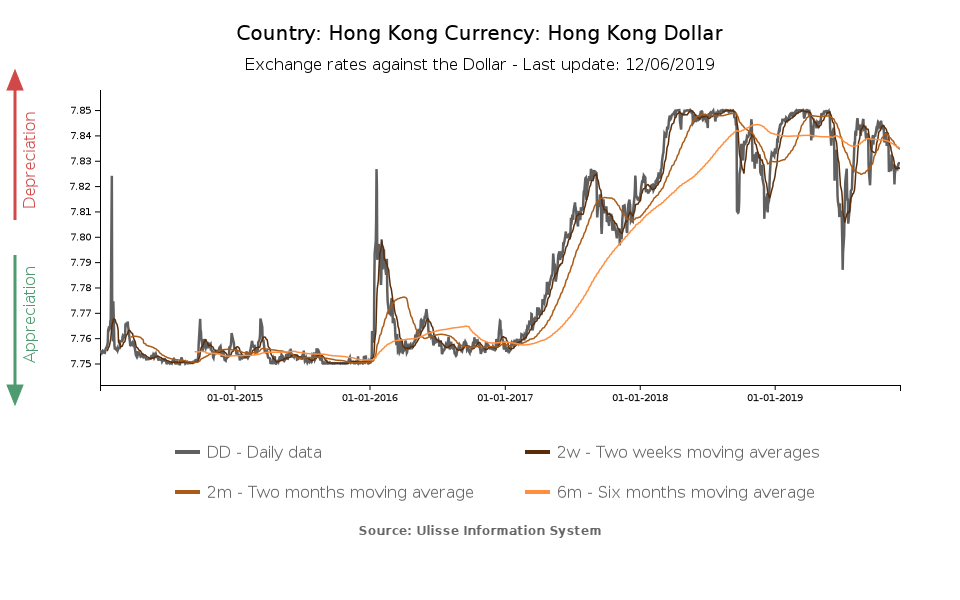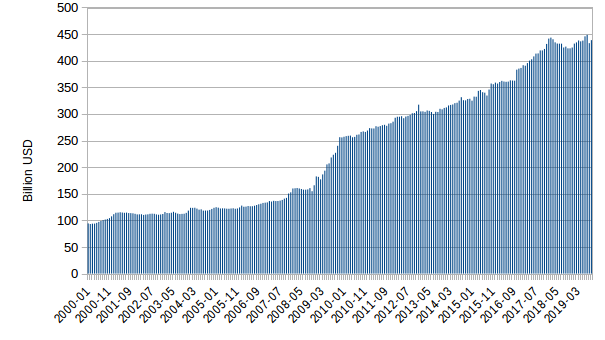Hong Kong: Social Unrest Weighs on the Economy
The currency shows resilience, thanks to its peg to the US dollar.
Published by Alba Di Rosa. .
Exchange rate Asia Central banks Trade war Uncertainty Chinese yuan Dollar Exchange ratesFor months now, the Hong Kong Special Administrative Region (SAR) has been the focus of media attention for its violent street protests, which started to oppose an extradition bill and then reached broader issues relating to democratic freedoms. The effects of the ongoing unrest are starting to weigh on the country's economy, while the currency - the Hong Kong dollar - has not shown dramatic reactions, thanks to its peg to the US dollar.
The monetary situation
A former British colony, Hong Kong gained its independence and became a SAR of China in 1997. A few years earlier, following the start of dialogues between the UK and China over the handover of Hong Kong, the currency suffered a confidence crisis and a consequent sharp depreciation. In 1983, the currency was pegged to the US dollar (Linked Exchange Rate System, LERS). In the following years, the peg has granted stability and development to the economy of the country, which now constitutes one of the largest global financial centers.
Following the street protests that started in early 2019, one of the issues raised by economists and international observers was the possibility that the dollar peg could be questioned, in the face of a situation now critical on several fronts. As a matter of fact, Hong Kong's economy is suffering as a result of the unrests, trade war and the slowdown of Chinese economy.

As you can see from the chart, the Hong Kong LERS system allows the currency to fluctuate in the range of 7.75-7.85 HKD for 1 USD. The dynamics of the last 5 years shows a relative stability before 2017, followed by a depreciation in 2017 - simple consequence of the large amount of cheap liquidity available in the economy. Since 2018, when the trade war began, and then in 2019, when unrest started, the HKD exchange rate has constantly remained at the top of the fluctuation band.
Hong Kong dollar: peg likely to hold
Several factors seem to threaten the stability of the peg; nonetheless, most analysts agree that an unpegging is extremely unlikely. The reasons can be summarized as follows:
- The nature of Hong Kong's exchange rate regime as a linked exchange rate system is established in the country's Basic Law. If the peg became unsustainable, the possibility would be twofold: loosen the fluctuation band or change the anchor currency. The first choice could fuel speculation and reduce the credibility of the Hong Kong Monetary Authority (HKMA), the country's de facto central bank; the second option, which would inevitably lead to the yuan, would be premature, given that the Chinese currency is not a fully convertible currency. Such a characteristic is indispensable for a country like Hong Kong, a major global financial centre.
- The political will to maintain the peg, as expressed by the Hong Kong government, is very strong.
- HKMA's resources are sufficient to defend the peg, even in the case of a speculative attack. The LERS system is in fact a currency board, whose primary task is to maintain the stability of the exchange rate. The Hong Kong Monetary Authority pursues this objective by selling HKD for USD in case of an excessive strengthening of the local currency (when demand exceeds supply), and vice versa demands HKD and sells USD in case of a depreciation.
The currency board system ensures greater resilience to speculative attacks compared to a normal fixed exchange rate regime, as it provides to keep as FX reserves an amount of anchor currency at least equal to the monetary base.
In the case of Hong Kong, reserves in US dollars amount, in October, to more than twice its monetary base (i.e. the money issued by the central bank).
Hong Kong: foreign exchange reserves (2000-2019)
Source: StudiaBo elaborations on ExportPlanning data.
The economic outlook
While on the currency front the situations look, all in all, under control, Hong Kong is beginning to suffer blows at the economic level.
- Technical Recession
Considering seasonally adjusted values, in Q3-2019 the country's GDP contracted by 3.2% compared to the previous quarter and by 0.5% in Q2, officially entering a technical recession. - Reduction of trade flows
In the last 2 quarters, Hong Kong recorded a contraction in both imports and exports of goods of more than 5%; the reduction in trade in services was slightly lower. - Retail sales showed a negative performance since the beginning of 2019. The biggest contraction of the year was recorded in October: -26.2% y-o-y.
- Decline in tourism
In the first 10 months of the year, tourist arrivals recorded a drop of almost 44% compared to the same period in 2018.
Although macroeconomic fundamentals are sound, the concurrent effect of domestic chaos and a weak international economy is weighing on the Hong Kong's economy. If the context of global uncertainty and weak growth is now becoming a new normal, the resolution of the discontent at the root of social unrest emerges as a priority for an effective improvement in the country's short-term economic prospects.



